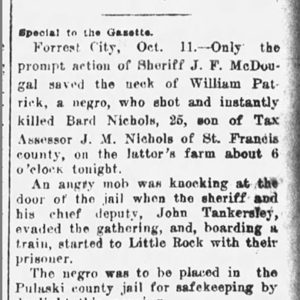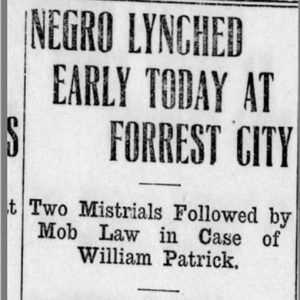calsfoundation@cals.org
William Patrick (Lynching of)
On December 3, 1915, an African-American man named William Patrick was lynched in St. Francis County for allegedly killing a young white man named Bard Nichols in October of that year.
There is very little information available about William Patrick. In 1900, there was an eighteen-year-old African American by that name boarding in Franks Township in St. Francis County and working on a farm. He could both read and write. In 1910, there was an African American named W. D. Patrick living in Franks Township; his age is listed as thirty-six at the time, making him a slightly more likely candidate. He was a farmer living with his wife and four small children. If Patrick was fifty-five years old as reported in the newspapers, however, neither is likely him. There is much more information available on Bard Nichols. He was the son of merchant, landowner, and St. Francis County tax assessor John M. Nichols. School records indicate that he graduated as valedictorian of his class at Crowley’s Ridge Academy in May 1907. He then attended the University of Arkansas (UA) in Fayetteville (Washington County), where he is listed in the 1910 yearbook. According to the census taken that year, he was nineteen years of age and was living in St. Francis County with his father, his fifteen-year-old sister Helen, and his grandmother, Annie H. Bard. At the time of his death, Bard Nichols was head of the Forrest City transfer company and had a retail coal business. Bard Nichols is buried in the Forrest City Cemetery.
According to newspaper reports, on October 11, 1915, Bard Nichols went out to his family’s farm near Beck Spur, between Forrest City (St. Francis County) and Palestine (St. Francis County), to settle up with Patrick, who had raised a crop on the farm that year. There was a quarrel over the settlement, and Patrick shot Nichols through the heart. A December 3 article in the Arkansas Gazette, however, reported that Patrick had a different account of the events, maintaining that Nichols had threatened him and knocked his daughter down. Whatever instigated the murder, news of the incident spread, and a crowd gathered and stormed the Forrest City jail where Patrick was in custody. The mob failed, however, to guard the back door of the building, and Sheriff J. F. McDougal and chief deputy John Tankersly managed to evade them and take Patrick to Little Rock (Pulaski County). Word spread among the mob, however, that officers had gone to nearby Wynne (Cross County), and members of the mob made preparations to travel there before hearing that Patrick had been taken to the state capital.
Patrick was tried for his alleged crime in Forrest City, but the trial ended in a hung jury. A second trial, which ended on December 1, produced the same result. Local citizens, apparently concerned that Patrick “would escape the death penalty,” attacked the jail after midnight. The Pine Bluff Daily Graphic reported that it was not known if the jailor was on duty at the time, how the crowd gained entry, or how big the mob was (numbers cited in the media range from fifteen masked men to 100 people). Patrick reportedly begged for his life before being hanged from a pole. According to the Daily Graphic, “The lynching was conducted so quietly that no one knew it had been enacted until early this morning (December 3) when the body of the victim was found dangling from a pole a short distance from [Forrest City].” Unlike what occurred in many lynchings, the mob did not subsequently shoot at the corpse. The report of the coroner found that Patrick had died “at the hands of unknown persons.”
At the time of a December 4, 1915, report by the Arkansas Gazette, Patrick’s body had not yet been claimed despite the fact that he had “a wife and children living in this community.”
For additional information:
“Death at Hands [of] Unknown Person[s].” Arkansas Gazette, December 4, 1915, p. 18.
“Lynching Averted at Forrest City.” Arkansas Gazette, October 12, 1915, p. 1.
“Negro Lynched Early Today at Forrest City.” Pine Bluff Daily Graphic, December 3, 1915, p. 1.
“Negro Slayer Is Lynched at Forrest City.” Arkansas Gazette, December 3, 1915, p. 1.
“Negro Slayer Spirited Away.” Batesville Daily Guard, October 13, 1915, p. 1.
“Sheriff Outwits Mob.” Evening Times-Republican (Marshalltown, Iowa), October 12, 1915, p. 1.
Nancy Snell Griffith
Davidson, North Carolina
 Civil Rights and Social Change
Civil Rights and Social Change Early Twentieth Century, 1901 through 1940
Early Twentieth Century, 1901 through 1940 William Patrick Lynching Article
William Patrick Lynching Article  William Patrick Lynching Article
William Patrick Lynching Article  William Patrick Lynching Article
William Patrick Lynching Article 




Comments
No comments on this entry yet.